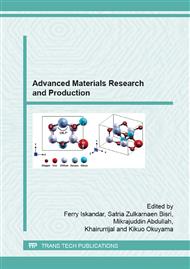p.349
p.353
p.359
p.363
p.367
p.373
p.377
p.381
p.385
Development of Sound Absorbent Material Based on Waste and Bamboo Fiber
Abstract:
Sound absorbent material is used to improve acoustic quality of room as it can damp noise level and reduce echo. As the manufacturing costs are quite expensive, nowadays, utilization of sound absorbent material is still limited to commercial needs, such as karaoke room, movie theater and music studio. Utilizing waste into sound absorbent materials can provide multiple benefits as it can reduce production cost and landfill waste as well. This research was conducted experimentally with parameter measured was sound absorption coefficient. An organic waste such as vegetable waste and an inorganic waste such as plastic, paper, and fabrics waste were processed through crushing and drying process. The processed material was mixed with bamboo fiber and an organic Nano silica (rice husk). The Compound was used as filler and was mixed with polyvinyl acetate (PVAc) as a matrix. From this research, it was concluded that composite material from waste with bamboo fiber could qualify ISO 11654, 1997 standard as a sound absorbent material E class category with weighted sound absorption coefficient value, αw= 0,25(M). This material has a good sound absorption quality in frequency range 500-1250 Hz with highest absorption α = 0.82 at 800 Hz.
Info:
Periodical:
Pages:
367-370
Citation:
Online since:
July 2015
Price:
Сopyright:
© 2015 Trans Tech Publications Ltd. All Rights Reserved
Share:
Citation:


